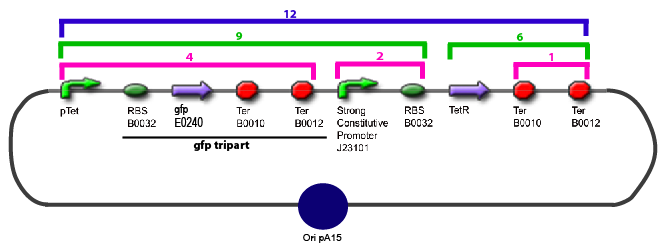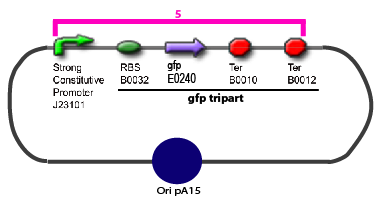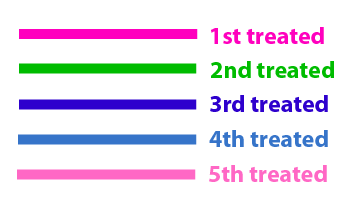!
- For each new extraction it's important to have a new bath of ETB
- Use a new blade for each extraction
- The band weight must be less than 200 mg
Amplification of promoters
=>To amplify the sequence in order to have enough amount of DNA to carry out the following of our experiments.
- Preparation of the templates : Resuspend of 1 colony in 100µl of water.
- Preparation of PCR mix :
For each samples,
1 µl dNTP
10 µl Buffer Phusion 5x
2,5 µl Oligo_F
2,5 µl Oligo_R
1µl template
1 µl Phusion
50 µl qsp H2O (33µl)
- make a mix with buffer, oligos and water for n+1 samples
- negative control : without template
- positive control : known template
LID : 105°C
1. 98°C 30 sec initial denaturation
2. 98°C 10 sec denaturation
3. 60°C (depending of the size of oligos) 30 sec annealing
4. 72°C (1 min for 1 kb)
5. go to : 2 rep : 24-29
6. 72°C 5 min
7. sound : 1
8. hold : 10°C
Purification (Kit Promega)
Gel Slice and PCR Product Preparation
Dissolving the Gel Slice
- Following electrophoresis, excise DNA band from gel slice in a pre-weighed 1.5 mL microcentrifuge tube.
- Add 10µL membrane Binding Solution per 10 mg of gel slice. We prefer not to vortex and we incubate at 50-65°C until gel slice is completely dissolved (∼10 min). Quick centrifuge.
Processing PCR reactions
For products above 40 pb
- Add an equal volume of Membrane Binding Solution to the PCR reaction.
Binding of DNA
- Insert the SV Minicolumn into Collection Tube.
- Transfer dissolved gel mixture or prepared PCR product to the Minicolumn assembly. Incubate at room temperature for 1 minute.
- Centrifuge at 16,000 x g for 1 minute. Discard the flowthrough and reinsert Minicolumn into Collection Tube.
Washing
- Add 700 µL Membrane Wash Solution (ethanol added). Centrifuge at 16,000 x g for 1 minute. Discard flowthrough and reinsert the Minicolumn into Collection Tube.
- Repeat Step 4 with 500 µL Membrane Wash Solution. Centrifuge at 16,000 x g for 5 minutes.
- Empty the Collection Tube and recentrifuge the column assembly for 1 min with the microcentrifuge lid open (or off) to allow evaporation of any residual ethanol.
Elution
- Carefully transfer Minicolumn to a clean 1.5 mL microcentrifuge tube.
- Add 30 µL Buffer EB (Qiagen). Incubate at room temparature for 1 minute. Centifuge at 16,000 x g for 1 minute.
- Discard Minicolumn and store at 4 or -20°C.
Quantification by electrophoresis
- Gel : 1.5-2% agarose with BET added (5 µL BET for 100 mL TBE)
- 10 µL Quick-Load 1 kb DNA Ladder
- 2 µL LB + 3 µL DNA
Ligation
- 2 µL Ligase Buffer 10X
- Vv µL of measured [DNA]Vector in ng/µL (30 to 50 ng)
- Vi µL of measured [DNA]Insert in ng/µL
- Pure water QSP 20 µL
- 1 µL T4 DNA ligase at 400 000 U/mL concentration
- O/N at 16°C
Vi = (3 x [DNA]Vector x Vv x LenghtInsert) / ([DNA]Insert x LenghtVector)
Transformation
Use of TOP10 chemically competent cells
- Defroze competent cells on ice during 5'
- Add 5 µl of DNA Ligation in 50 µL of competent bacterias (or 1 µL for the positive control puc19)
- Incubate 30' on ice
- Heat-shock the cells during 30" at 42°C without shaking
- Put 2' on ice
- Add 250 µL of pre-warmed SOC medium (42°C)
- Incubate 1h at 37°C under shaking (225rpm)
- Spin at 5.000rpm during 30"
- Remove 150 µL of supernatant
- Resuspend the pellet in the 150 µL left
- Spread on adequated plates
- Incubate O/N at 37°C
PCR Screening
Use of 8 clones of Ligation transformants for screening PCR
- One toothpick of each clone's colony per PCR tube
- Use toothpick to start 7.5mL O/N culture
After, add
- 12.5 µL Mix
- 0.5 µL Oligo F (10µM)
- 0.5 µL Oligo R (10µM)
- 11,5 µL pure water
- negative control : without clone's colony
- positive control
Store the tubes on ice waiting for PCR attains 95°C then put the tubes in the machine
LID 105°C
1. 95°C 5min
2. 95°C 30 sec
3. 55°C 30 sec
4. 72°C (1 min for 1kb)
5. go to : 2 rep : 29
6. sound : 1
7. hold : 4°C
Electrophoresis Purification of PCR
- 10µl of ladder 100 pb or 1 kb
- 4 µl of screening PCR
- Migration at 100V on 1,5% gel until 3/4 way
Sequencing
voir ici -> [http://institut.cochin.inserm.fr/rubric_recherche/Plates-Formes/sequencage_genomique/I18NFolder.2005-02-10.4781618697/page2/fr Sequencing COCHIN]
Promoter Characterization Plan
For theoretical consideration, see estimation of parameters





The same colour coded steps can be perfomed at the same time if elements needed are available
The order for treating the colours should of course be:

|
| Availability
|
| Promoters
|
| J23101
| yes
|
| pTet
| yes
|
| PflhDC
| ?
|
| PfliA
| ?
|
| PfliL
| ?
|
| PflgA
| yes
|
| PflgB
| yes
|
| PflhB
| yes
|
| Genes
|
| tetR
| yes
|
| gfp E0240
| yes
|
| ompR*
| ?
|
| envZ*
| ?
|
| fliA
| no
|
| flhDC
| yes
|
| Plasmids
|
| PSB3K3
| yes
|
| RBS
|
| B0032
| ?
|
| Terminators
|
| B0010
| ?
|
| B0012
| ?
|
| Bacterial Strains
|
| Top10
| yes
|
| FliA -/ FlhDC -
| ask Ariel
|
| FlgM -
| ask Ariel
|
This table contains the promoters we need to characterize, the transcription factors whose effect on the promoter we want to test, and the plasmid we want to obtain in order to carry out each characterization
| Promoter
| Promoter
Availability
| TF gene
| TF gene
Availability
| Done/Not done
|
| J23101
| yes
|
|
|
|
| pTet
| yes
|
| ?
|
|
|
|
| tetR
| yes
|
|
| None
| ?
| gfp E0240
| yes
|
|
| PflhDC
| ?
| ompR*
| ?
|
|
| PflhDC
| ?
| envZ*
| ?
|
|
| PflhDC
| ?
| fliA
| no
|
|
| PfliA
| ?
| flhDC
| yes
|
|
| PfliA
| ?
| fliA
| no
|
|
| PfliL
| ?
| flhDC
| yes
|
|
| PfliL
| ?
| fliA
| no
|
|
| PflgA
| yes
| flhDC
| yes
|
|
| PflgA
| yes
| fliA
| no
|
|
| PflgB
| yes
| flhDC
| yes
|
|
| PflgB
| yes
| fliA
| no
|
|
| PflhB
| yes
| flhDC
| yes
|
|
| PflhB
| yes
| fliA
| no
|
|
Protocol to make competent bacteria
1. Use non competent bacteria (ex: MG1655) stocked in 1.5 mL LB (20% Glycerol): put a toothpick in the 1.5 mL stock tube and then place it in a 50 mL Falcon with 5 ml LB medium. Over Night culture at 37°C / 300 rpm
2. 1/100 dilution in LB medium QSP 50 mL in an erlenmeyer of 250 mL
3. Culture at 37°C / 300 rpm untill OD600 reach 0.6
4. Fast cooling at +4°C by gently shaking the erlen in ice
Before: prepare CaCl2 0.1M.
- Add 5,56 g in 500 mL H2O (Gibco)
- dissolve the CaCl2 by mixing the suspension with the help of a magnetic stirrer
- Filter the solution with a cell-culture unit of filtration
- Aliquotes the filtered solution: 25mL in a 50 mL Falcon. Storage at +4°C
5. Use pre-cooled centrifuge at +4°C. Centrifuge 50 mL of the culture in 50 mL falcon: +4°C / 5 min / 5000 rpm
6. Discard supernatant by inverting the tube, and resuspend the pellet with 1 mL of cold CaCl2 and mix gently the suspension by up and down
7. Add cold CaCl2 QSP 20 mL and incubate 30 min / +4°C
8. Centrifuge the suspension : +4°C / 5 min / 5000 rpm
9. Discard supernatant by inverting the tube, and resuspend the pellet with 1 mL of cold CaCl2 and mix gently the suspension by up and down
10. Pre-warm the bain-marie at 42°C
11. Add 2 µL of 1/100 diluted plasmid (containing a strong constitutive promoter [http://partsregistry.org/Part:BBa_J23101 J23101] before the [http://partsregistry.org/Part:BBa_E0240 GFP tripart]) to 100 µL of competent bacteria in a 15 ml falcon
12. Incubate 20 min at +4°C
13. Heat-Shock: 40 sec at 42°C / then 1 min in ice
14. Add to the sample 1 mL LB medium without antibiotic and incubate 1h at 37°C / 300 rpm
15. Spread 10 to 100 µL on plates with LB medium and the appropriate antibiotic
16. Incubate O/N at 37°C / 300 rpm
17. Prepare a Glycerol Stock or/and use the transformed bacteria to study the doubling time of the bacteria population
Study of the doubling time of the bacteria population
- B1 Vitamin 0.1%
- Uracile 0.2%
- MgSO4 2 mM
- CaCl2 0.1 mM
- Glycerol 0.4%
- Casamino acids 0.1%
- M9 minimal salts medium 1x
- H2O QSP 200 mL
- Filter the medium with a cell-culture unit of filtration
- Unfreeze strains from the glycerol stock containing or not the plasmid with a contitutive promoter and a fluorescent reporter gene
- Put a toothpick in the 1.5 mL stock tube and then place it in a 50 mL Falcon with 5 ml of the medium above. Over Night (16h) culture at 37°C / 300 rpm
- Measure the OD600 (Linear Zone Measurement <1.5)
- Dilute the culture medium in the same new medium to obtain an approximative OD600 of 0.01 (Vfinal= 50 mL in a 250 ml erlenmeyer)
- Incubate à 37°C / 300 rpm and measure the OD600 every 20 min
- Determine the doubling time population and compare the strains containing or not the plasmid with a contitutive promoter and a fluorescent reporter gene
|  "
"






